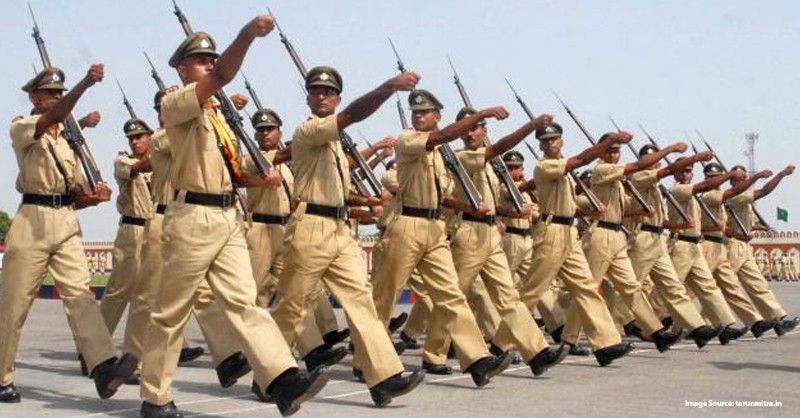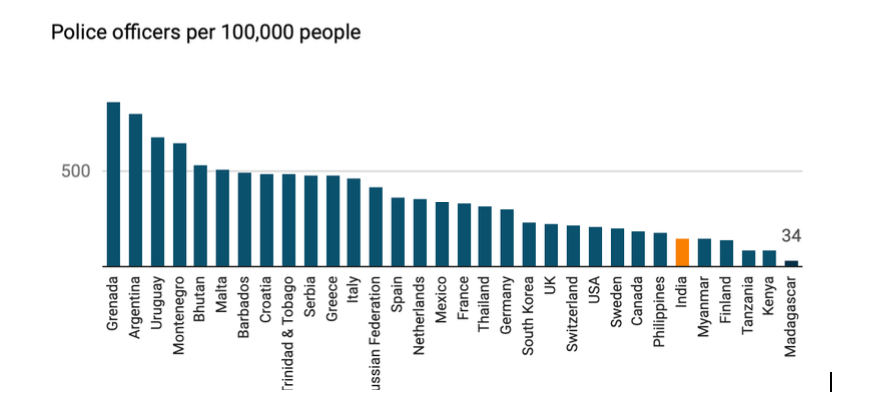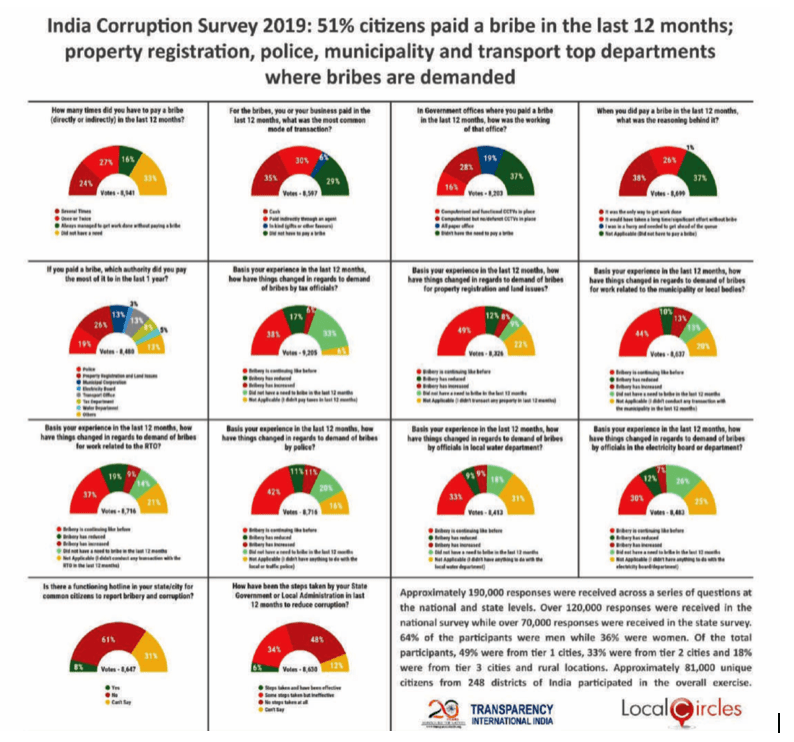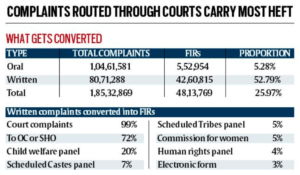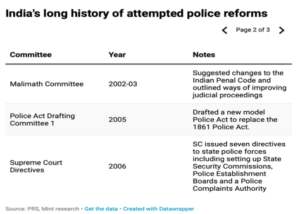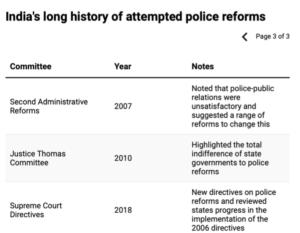This post has been written by Seher Bhalla, a student of Symbiosis Law School Pune.
Mahatma Gandhi, the father of our nation can be considered the epitome of non-violent and peaceful action. Yet in a twist of cruel irony in 2019 India’s rank in the global peace index was 141 out of 163[1]. One of the key factors in peace index is the perception and relation of the Police with the community. India has an average score above two in the field which is an alarming statistic because it shows the deterioration of the force’s perception in the country. This lack of trust can and will translate into a system where people will be and in fact are hesitant to approach the police with their problems which can have a dire impact on the crime situation in the country with more and more being committed to a larger extent solely because of lack of a reporting by citizens. In fact a 2018 report stated that, “Only three in every ten people said that they had significant levels of trust in senior police officers and two in every ten in the local police. Lowest levels of trust were reported for traffic police (16%)[2].”
Therefore, this leads us to two question: a) Why is the police feared to this extent?, But more importantly, b) What can be done to improve the state of policing in order to raise is to effective from merely functional? In this paper we will look at both of these in terms of historical instances and suggestions for the future.
THE LAWS GOVERNING POLICE
The Indian Police force has largely been governed by the Indian Police Act, 1861, which is a colonial era relic that has seen little to no major change. Considered a largely quasi-federal subject both states and the central governments have a say in the functioning of police personnel though the balance tips in favour of the centre. The was passed by the British Colonial rulers whose aim was to subjugate and control Indians into being subservient and in fear of their rulers, the act’s essence was to control the masses not secure them. So even though it was adopted by an independent India the essence still remains one of control.
In fact some states came up with their on laws for the police but ended up further giving arbitrary powers to police,” The new enactments were patterned on the model of the old 1861 legislation. In fact, some of these state Acts, like the Bombay Police Act, 1952 further tightened the executive control over the police force, without introducing any safeguards to prevent the misuse of police force for partisan purposes and without incorporating effective mechanisms to ensure police accountability.[3]”
IMPACT OF THE LAW
If you type the terms “abuse of power by police in India ” or “police brutality in India” in any search engine there will be innumerable reports, instances, articles, papers and images to back all these up. Officials under conditions of anonymity have explained the various torture forms used to extract information and how encounter killings are a norm. All of these seems to be extremely horrid but in country where the officers are overworked, understaffed[4] and under threat of actions from seniors and politicians it becomes easier to understand their stance but not justify it. The success or survival of a person in the force should not be considered above that of a fruit-seller or a victim.
ABUSE OF POWER
The corruption practices of police is stuff movies are made of ,literally! But, why is it considered a norm and not a problem. Part of the reason is the immunity that both the laws set in place and the actual network of seniors and politicians provide which acts as an incentive to keep the system the way it is and not change or upset it.
According to a Transparent India report cases of corruption by police officials went from 13% to 33%. Furthermore the national average of bribes paid by citizens was 51%[5].
In order to keep up with the demands of their seniors and enjoy these protections officers often indulge in an arbitrary misuse of powers by not filing reports in issues of varying degree which are beyond the ‘petty issues’ they have the legal power to say no to. In fact the method of filing a complaint was seen to further increase or decrease the chances of success or failure.[6]
POLICE BRUTALITY
As mentioned earlier the aim of police in India is largely seen as that of control. From the current streak of violence against those who go out unnecessarily amidst the lockdown to the brutal action against students and anti-CAA protesters and other unrelated protests, the ease with which violence is. Used as a measure of control was definitely an unsettling observation but not a new one[7]. What’s even more disturbing is what happens to those in custody, with brutal and bone-chilling torture techniques being norm and even more so when the person is not politically connected.
“A fruit vendor in Varanasi described how police tortured him to extract confessions to multiple, unrelated false charges:
“[M]y hands and legs were tied; a wooden stick was passed through my legs. They started beating me badly on the legs with lathis (batons) and kicking me. They were saying, ‘You must name all the members of the 13-person gang.’ They beat me until I was crying and shouting for help. When I was almost fainting, they stopped the beating. A constable said, ‘With this kind of a beating, a ghost would run away. Why won’t you tell me what I want to know?’ Then they turned me upside down… They poured water from a plastic jug into my mouth and nose, and I fainted.””[8]
“She was kept in the police station all night. In the morning, when we went to meet her, they said she had killed herself. They showed us her body, where she was hanging from a tree inside the police station. The branch was so low, it is impossible that she hanged herself from it. Her feet were clean, although there was wet mud all around and she would have walked through it to reach the tree. It is obvious that the police killed her and then pretended she had committed suicide.”
– Brother-in-law of Gita Pasi, describing her death in police custody in Uttar Pradesh in August 2006
“We have no time to think, no time to sleep. I tell my men that a victim will only come to the police station because we can give him justice, so we should not beat him with a stick. But often the men are tired and irritable and mistakes take place.”
– Gangaram Azad, a sub-inspector who heads a rural police station in Uttar Pradesh state[9]
All of these are accounts of victims and those on the side of perpetrators. Brutality as a solution will never ever benefit those in the wrong but will cause psychological damage to both officers in-charge of it and the person on the receiving end. The only benefit is to those in power who get to show a reduction in crime and complaints lodged with the real reason being fear of reporting not elimination of crime, but the. Latter. Is rarely revealed.
In December 2019 the horrific crime of gang-rape took place in Hyderabad, the police got into investigative mode quickly and nabbed the four accused. But in a turn of events they were allegedly taken. Out. In the middle of the night and shot by police in an encounter/extrajudicial killing. Rape or any other crime is a serious issue which is why the Constitution of India provides for a proper format to induce punishments including death penalty to perpetrators but by taking justice into their own hands the officers showcased a zero fear of the system and proved that their powers are tantamount and those suspected will face harsh consequences whether they are innocent or not. Thus the very basic rule of ‘innocent until proven guilty’ was thrown out of the window solely due to social pressure.
MOVING AHEAD: FOCUSING ON BETTER POLICING SOLUTIONS
All hope is not lost though and in a tale as old as time effective solutions have been proposed by various platforms, organisations and authorities like the Supreme Court of India. But like most solutions they have yet to see effective implementation. In fact Prakash Singh v. Union of India[10] is the very judgement where Supreme Court proposed reforms, the very reforms that have gone largely ignored. The court has been seen as extremely progressive even today considering that the judgement came out in 2006 and neither the previous nor current government have made any major efforts to implement it.
The court focused. On two root problems which include functional autonomy and enhanced accountability[11].
The officer need monitored freedom where they are responsible for coming up with an area to area action plan, which gives them better control over effective use of resources and decreases the burden on them to be. Liable to seniors and politicians. When this powerful pressure is done away with officers will focus more on solutions for community rather than appeasing the higher ranks.
The gap between communities and police needs to be bridged, to ensure a situation of mutual trust and focus on prevention crime, rather than waiting for a stage of punishing the perpetrator. Therefore, to facilitate this NGOs, Citizen groups and other neutral third parties need to be involved in introduction of processes like open houses, awareness campaigns and so forth.
The third and most integral change is information trainee officers need to be given empathy training in order to ensure that they are more sensitive and perceptive of victims of crimes and are humane in their approach. This will go far in dispelling the apprehension of the common man especially those who come from marginalised backgrounds.
There is no dearth of solutions or lack of drive for change in citizens and police officers, both groups have been divided by unnecessary and dangerous borders drawn by those in power irrespective of the part. But the truth of the matter is that until unless radical change is introduced the position of both parties will remain largely helpless. There needs to be strict action from the judiciary’s end against the central and state governments for lack of compliance with the orders. Unless there is no change in the system the situation will gradually worsen with cops remaining ignorant to society and people remaining in fear.
SOURCES
[1] http://visionofhumanity.org/app/uploads/2019/06/GPI-2019-web003.pdf
[2] https://www.commoncause.in/pdf/SPIR2018.pdf
[3]https://www.humanrightsinitiative.org/publications/police/principles_of_a_model_police_bill.pdf
[4] https://www.livemint.com/news/india/india-s-police-force-among-the-world-s-weakest-1560925355383.html
[5] http://transparencyindia.org/wp-content/uploads/2019/11/India-Corruption-Survey-2019.pdf
[6] https://ncrb.gov.in/crime-india-2018
[7] https://www.washingtonpost.com/politics/2020/01/10/india-is-cracking-down-university-protests-heres-what-you-need-know/
[8] https://www.hrw.org/news/2009/08/04/india-overhaul-abusive-failing-police-system
[9] https://www.hrw.org/sites/default/files/reports/india0809web.pdf
[10] (2006) 8 SCC 1
[11]https://humanrightsinitiative.org/old/index.php?option=com_content&view=article&catid=54%3Aprogrammes&id=199%3Asupreme-court-directives-on-police-reform&Itemid=98
(The research for this topic was supported by Smrithi Foundation. Views expressed are personal)


